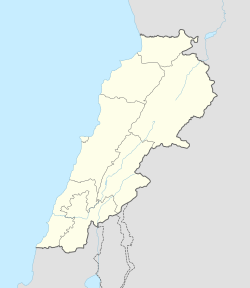Hardine
Hardîne حردين | |
|---|---|
village | |
| Etymology: | |
| Coordinates: 34°14′12″N 35°51′31″E / 34.23667°N 35.85861°E | |
| Country | Lebanon |
| Governorate | North Lebanon Governorate |
| District | Batroun District |
| [3] | |
Hardîne (Arabic: حردين), sometimes written Ḩardīn, is a village in Batroun District, North Lebanon Governorate, Lebanon.[1][2][4][5][6] Notable structures include the Temple of Mercury, severely damaged by an earthquake,[7] and several Christian churches and monasteries.
Demographics
In 2014 Christians made up 99.63% of registered voters in Hardîne. 94.30% of the voters were Maronite Catholics.[8]
History
According to jesuit father Louis Cheikho, Hardine is one of the first Christian settlements in Mount-Lebanon. It was home for 4 Patriarchs for over 140 years. Legend has it that fifteen Maronite nuns leaped from the Hardine cliff, choosing to embrace death rather than succumb to the dishonor of being captured by Mameluke soldiers during their campaigns.[9] [10]
Notable people from Hardîne
- Joseph Assaf, Australian ethnic marketing executive
- Nimatullah Kassab (1808-1858), named a saint by the Roman Catholic church
- Benjamin of Hardin, Maronite muqaddam who fought and died in the Kisrawan campaigns (1292–1305)
References
- ^ a b "Hardine". Les Plus Beaux Villages du Liban.
- ^ a b "20 Reasons To Visit Hardine In Lebanon". The961.com. December 6, 2020.
- ^ Hardine at GEOnet Names Server
- ^ "Top Things to Do in Hardine". Lebanon Untravelled.
- ^ "Lebanon's Hardine: A treasure trove off the beaten track". The Arab Weekly. 2018-06-24.
- ^ "Hardine, Lebanon". Fodel.net.
- ^ "Hardine, The Lourdes of Lebanon". Lebanon Untravelled.
- ^ https://lub-anan.com/المحافظات/الشمال/البترون/حردين/المذاهب/
- ^ Les Saints particulièrement honorés des Libanais, Beirut, 1914 (translated into French by Y. Moubarac)
- ^ La Nation maronite et la Compagnie de Jésus aux XVI et XVII siècles, Beirut, 1923. (Translated into French by Y. Moubarac, Beirut, 1984)
External links
- "Hardine - Beit Kessab". Localiban. 29 July 2015.


